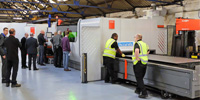18 December 2016
Is CO2 laser Cutting Now Obsolete?
 With the launch of 10 kW fibre laser cutting technology by Swiss firm Bystronic at EuroBlech, has dismissed the reason why a user should buy a CO2 laser cutting machine. Before the uses to have CO2 was to process thicker materials economically. Jon Till, joint owner of Accurate Laser Cutting, (recently became a fibre-only subcontractor) provided a user’s view explaining the advantages of fibre over CO2 laser cutting in terms of increased machine availability and productivity, lower running costs and greater versatility; and argues that the demise of CO2 is nigh. Mr Till has a background using laser cutting machines since 1999. The company he was involved with bought a Bystronic BySprint 3 kW CO2 model, swiftly followed by 4 kW and 4.4 kW versions and then the first 6 kW machine in 2002. In June 2015 saw the introduction of fibre laser cutting with the installation of a 6 kW BySprint Fibre with 4 m x 2 m capacity at Accurate Laser Cutting.
With the launch of 10 kW fibre laser cutting technology by Swiss firm Bystronic at EuroBlech, has dismissed the reason why a user should buy a CO2 laser cutting machine. Before the uses to have CO2 was to process thicker materials economically. Jon Till, joint owner of Accurate Laser Cutting, (recently became a fibre-only subcontractor) provided a user’s view explaining the advantages of fibre over CO2 laser cutting in terms of increased machine availability and productivity, lower running costs and greater versatility; and argues that the demise of CO2 is nigh. Mr Till has a background using laser cutting machines since 1999. The company he was involved with bought a Bystronic BySprint 3 kW CO2 model, swiftly followed by 4 kW and 4.4 kW versions and then the first 6 kW machine in 2002. In June 2015 saw the introduction of fibre laser cutting with the installation of a 6 kW BySprint Fibre with 4 m x 2 m capacity at Accurate Laser Cutting.
A 10 kW ByStar Fibre for processing sheet up to 3 m x 1.5 m has just been added, in November 2016, the first machine of such high power to be installed in the UK.
CO2 vs Fibre
6 kW is the practical limit for CO2 laser cutting, as higher power would burn the optics. Even power sources below this limit take their toll on the lenses and mirrors in a machine:
- leading to frequent downtime, cleaning, periodic replacement causes production downtime.
- If not maintained swapping the lens costs £270 each time, typically eight times per month. Mirror alignment is then scrutinised and adjusted if necessary.
- In addition, the purity of the assist gas may be too low, which affects the beam quality. Usually this is difficult to predict and often is the last thing that is checked, yet nevertheless it will typically happen twice a year.
Fibre laser cutting, avoids all of these problems. The solid state technology directs the beam down a fibre optic cable, causing no damage on conventional optics and does not degrade laser beam. Running costs of the machine are significantly lower, as electricity consumption is 60 per cent less. One other benefit of using fibre laser is that there less need to use expensive nitrogen, helium and carbon dioxide as laser assist gases. Productivity is dramatically increased using fibre. Mr Till states, “Our new 10 kW ByStar Fibre cuts 1 mm mild steel at 60 m/min, faster than our old CO2 laser was able to position its head (50 m/min) to start cutting. The speed and hence productivity advantage when processing thinner sheet is around three times, reducing for thicker materials.”
On the subject of the relative productivity of the two machine types, he suggested its tendency to drift out of tolerance a CO2 machine would need assistance running it overnight. With the fibre laser there is no assistance required. He notes that the technology has de-skilled operation to the point where on a fibre machine one simply presses a button and the machine starts producing, whilst there is still a lot of work involved in operating a CO2 machine.
CO2 technology has already been overtaken. Cutting capacities of the 10 kW Fibre laser source (and the 6 kW ByLaser CO2 source in brackets) are 25 mm (25 mm) in mild steel, 30 mm (25 mm) in stainless steel and 30 mm (16 mm) in aluminium. A fibre laser copes with cutting reflective materials much better than CO2, hence a superior performance in aluminium. For the same reason, the 10 kW Fibre can cut 15 mm brass and 12 mm copper, materials that CO2 cannot process at all without the risk of back reflections damaging the optics.
Finally, the costs comparisons of the two machines is £750,000 for a 10 kW fibre laser cutting centre and £500,000 for a 6 kW CO2 machine. It is an investment worth considering as the higher capital investment in fibre laser cutting is easily outweighed by the extra expense of running a CO2 machine and the latter’s very low residual value towards the end of its life.
He concludes, “A fibre laser can cut everything that a CO2 laser can process and very much faster in the case of thinner gauges. It is also able to tackle a much wider variety of materials, “It achieves accurate and repeatable results economically with very little machine downtime, raising production output day and night. In my view, this latest 10kW machine is a game changer in laser cutting machines.”
- Contact Information
- Name: David Larcombe
- Email: david.larcombe@bystronic.com
- Website: www.bystronic.co.uk/en/

